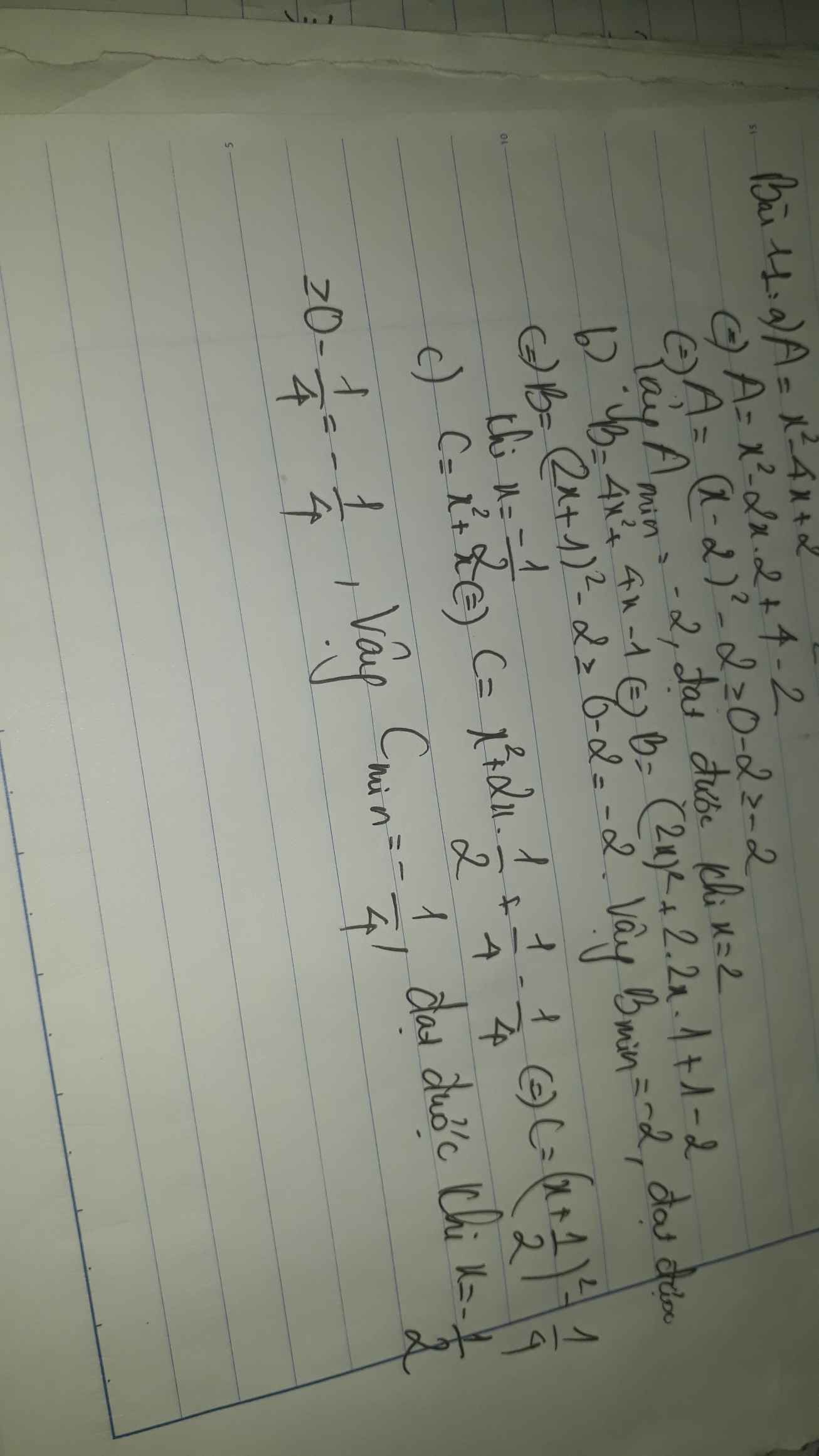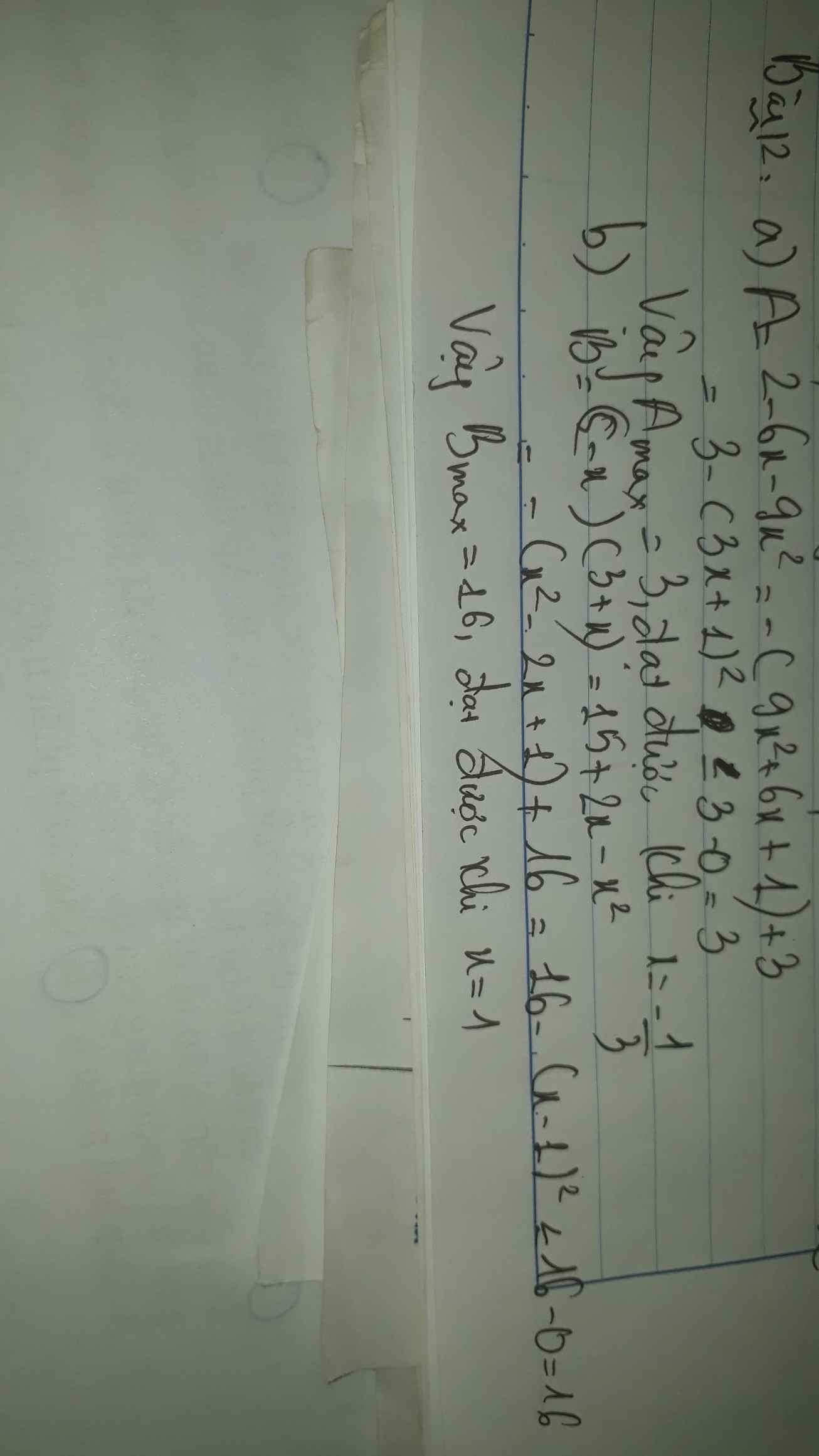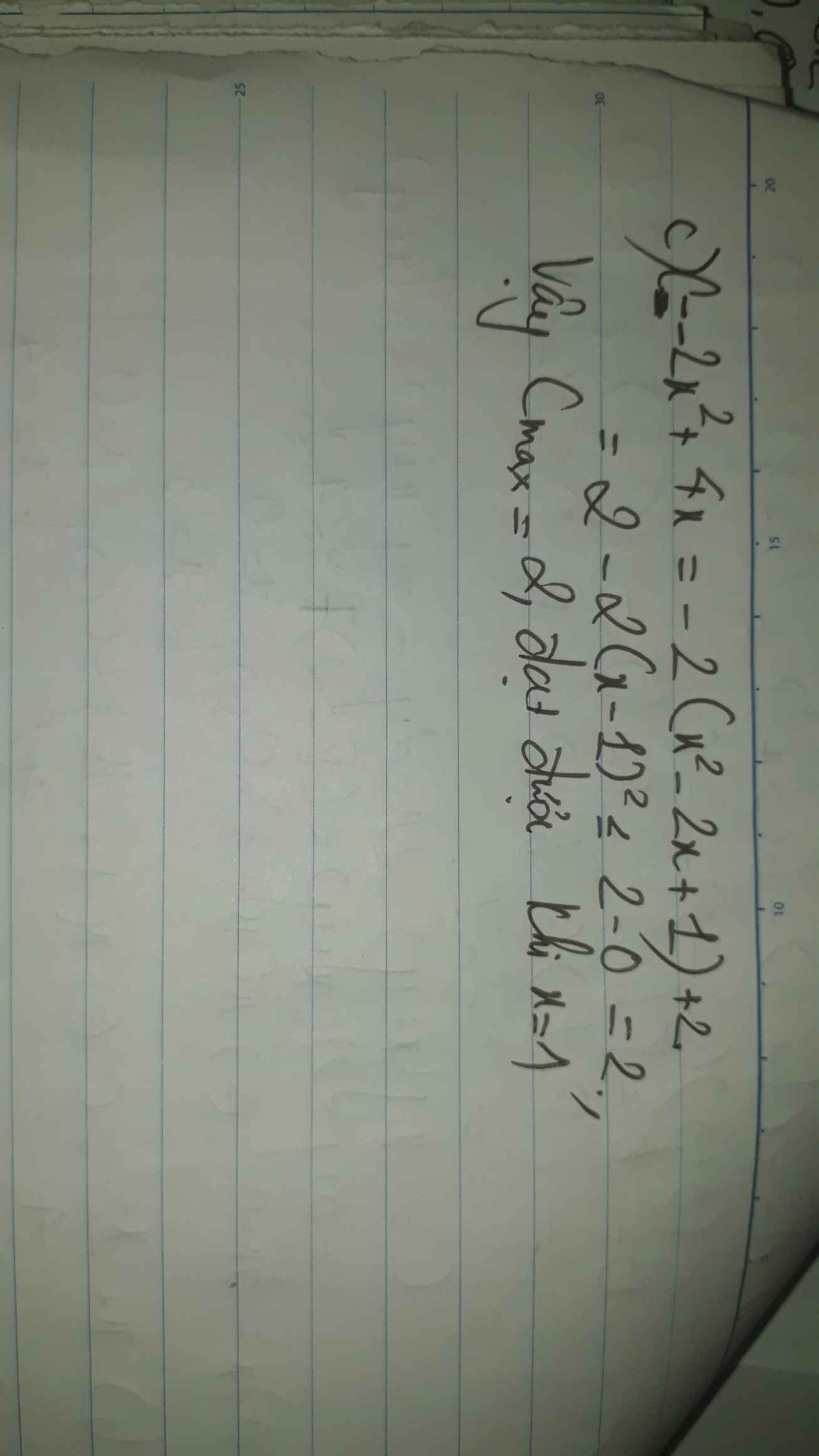cho
A=4x\(^2\)+4x+2
B=2x\(^2\)-2x+1
C=-15-x\(^2\)+6x
chứng minh A,B luôn dương và C luôn âm
Tìm GTLN(GTNN) của A,B,C
Hãy nhập câu hỏi của bạn vào đây, nếu là tài khoản VIP, bạn sẽ được ưu tiên trả lời.

Lời giải:
$C=-15-x^2+6x=-6-(x^2-6x+9)=-6-(x-3)^2$
Vì $(x-2)^2\geq 0$ với mọi $x\in\mathbb{R}$
$\Rightarrow C\leq -6< 0$
Vậy $C$ luôn âm.

Bài 1:
a) Ta có: \(A=-x^2-4x-2\)
\(=-\left(x^2+4x+2\right)\)
\(=-\left(x^2+4x+4-2\right)\)
\(=-\left(x+2\right)^2+2\le2\forall x\)
Dấu '=' xảy ra khi x=-2
b) Ta có: \(B=-2x^2-3x+5\)
\(=-2\left(x^2+\dfrac{3}{2}x-\dfrac{5}{2}\right)\)
\(=-2\left(x^2+2\cdot x\cdot\dfrac{3}{4}+\dfrac{9}{16}-\dfrac{49}{16}\right)\)
\(=-2\left(x+\dfrac{3}{4}\right)^2+\dfrac{49}{8}\le\dfrac{49}{8}\forall x\)
Dấu '=' xảy ra khi \(x=-\dfrac{3}{4}\)
c) Ta có: \(C=\left(2-x\right)\left(x+4\right)\)
\(=2x+8-x^2-4x\)
\(=-x^2-2x+8\)
\(=-\left(x^2+2x-8\right)\)
\(=-\left(x^2+2x+1-9\right)\)
\(=-\left(x+1\right)^2+9\le9\forall x\)
Dấu '=' xảy ra khi x=-1
Bài 2:
a) Ta có: \(=25x^2-20x+7\)
\(=\left(5x\right)^2-2\cdot5x\cdot2+4+3\)
\(=\left(5x-2\right)^2+3>0\forall x\)
b) Ta có: \(B=9x^2-6xy+2y^2+1\)
\(=9x^2-6xy+y^2+y^2+1\)
\(=\left(3x-y\right)^2+y^2+1>0\forall x,y\)
c) Ta có: \(E=x^2-2x+y^2-4y+6\)
\(=x^2-2x+1+y^2-4y+4+1\)
\(=\left(x-1\right)^2+\left(y-2\right)^2+1>0\forall x,y\)

Lời giải:
Biểu thức C không có nhiệm vụ gì trong bài thì bạn không cần đề cập đến nó.
Ta có:
$A=4x^2+4x+2=(4x^2+4x+1)+1=(2x+1)^2+1$
Vì $(2x+1)^2\geq 0$ với mọi $x\in\mathbb{R}$
$\Rightarrow A=(2x+1)^2+1\geq 1>0$
Vậy $A$ luôn dương.
$B=2x^2-2x+1=2(x^2-x+\frac{1}{4})+\frac{1}{2}$
$=2(x-\frac{1}{2})^2+\frac{1}{2}\geq \frac{1}{2}>0$
Do đó $B$ luôn dương.
Tiến Trung 2008: Vì trong bài bạn chỉ nêu CM $A,B$ dương nên sự tồn tại của $C$ là không cần thiết.

`A=(2x)^2+2.2x.1+1^2+1=(2x+1)^2+1`
`=> A_(min)=1 <=>x=-1/2`
`B=(\sqrt2x)^2-2.\sqrt2 x . \sqrt2/2 + (\sqrt2/2)^2 + 1/2`
`=(\sqrt2x-\sqrt2/2)^2+1/2`
`=> B_(min)=1/2 <=> x=1/2`
`C=-(x^2-2.x.3+3^2+6)=-(x-3)^2-6`
`=> C_(max)=-6 <=> x=3`

Bài 5:
a) \(A=x^2-4x+9=\left(x^2-4x+4\right)+5=\left(x-2\right)^2+5\ge5\)
\(minA=5\Leftrightarrow x=2\)
b) \(B=x^2-x+1=\left(x^2-x+\dfrac{1}{4}\right)+\dfrac{3}{4}=\left(x-\dfrac{1}{2}\right)^2+\dfrac{3}{4}\ge\dfrac{3}{4}\)
\(minB=\dfrac{3}{4}\Leftrightarrow x=\dfrac{1}{2}\)
c) \(C=2x^2-6x=2\left(x^2-3x+\dfrac{9}{4}\right)-\dfrac{9}{2}=2\left(x-\dfrac{3}{2}\right)^2-\dfrac{9}{2}\ge-\dfrac{9}{2}\)
\(minC=-\dfrac{9}{2}\Leftrightarrow x=\dfrac{3}{2}\)
Bài 4:
a) \(M=4x-x^2+3=-\left(x^2-4x+4\right)+7=-\left(x-2\right)^2+7\le7\)
\(maxM=7\Leftrightarrow x=2\)
b) \(N=x-x^2=-\left(x^2-x+\dfrac{1}{4}\right)+\dfrac{1}{4}=-\left(x-\dfrac{1}{2}\right)^2+\dfrac{1}{4}\le\dfrac{1}{4}\)
\(maxN=\dfrac{1}{4}\Leftrightarrow x=\dfrac{1}{2}\)
c) \(P=2x-2x^2-5=-2\left(x^2-x+\dfrac{1}{4}\right)-\dfrac{9}{2}=-2\left(x-\dfrac{1}{2}\right)^2-\dfrac{9}{2}\le-\dfrac{9}{2}\)
\(maxP=-\dfrac{9}{2}\Leftrightarrow x=\dfrac{1}{2}\)

a) \(A=x^2-2x+5\)
\(=\left(x^2-2x+1\right)+4\)
\(=\left(x-1\right)^2+4\)
Vì \(\left(x-1\right)^2\ge0;\forall x\)
\(\Rightarrow\left(x-1\right)^2+4\ge0;\forall x\)
b) a sẽ làm tắt 1 vài bước nhé khi nào kiểm tra thì em làm theo mẫu a là được
\(B=4x^2+4x+11\)
\(=4\left(x^2+x+\frac{11}{4}\right)\)
\(=4\left(x^2+2.x.\frac{1}{2}+\frac{1}{4}-\frac{1}{4}+\frac{11}{4}\right)\)
\(=4\left[\left(x+\frac{1}{2}\right)^2+\frac{10}{4}\right]\)
\(=4\left(x+\frac{1}{2}\right)^2+10\ge10;\forall x\)
Dấu "=" xảy ra \(\Leftrightarrow\left(x+\frac{1}{2}\right)^2=0\)
\(\Leftrightarrow x=\frac{-1}{2}\)
Vậy \(B_{min}=10\Leftrightarrow x=\frac{-1}{2}\)
c) Tìm GTLN nhé
\(C=5-8x-x^2\)
\(=-x^2-2.x.4-16+16+5\)
\(=-\left(x+4\right)^2+21\)
Vì \(-\left(x+4\right)^2\le0;\forall x\)
\(\Rightarrow-\left(x+4\right)^2+21\le21;\forall x\)
Dấu "="xảy ra\(\Leftrightarrow\left(x+4\right)^2=0\)
\(\Leftrightarrow x=-4\)
Vậy\(C_{max}=21\Leftrightarrow x=-4\)
A = x2 - 2x + 5
= ( x2 - 2x + 1 ) + 4
= ( x - 1 )2 + 4 ≥ 4 > 0 ∀ x ( đpcm )
B = 4x2 + 4x + 11
= ( 4x2 + 4x + 1 ) + 10
= ( 2x + 1 )2 + 10 ≥ 10 ∀ x
Đẳng thức xảy ra <=> 2x + 1 = 0 => x = -1/2
=> MinB = 10 <=> x = -1/2
C = 5 - 8x - x2
= -( x2 + 8x + 16 ) + 21
= -( x + 4 )2 + 21 ≤ 21 ∀ x
Đẳng thức xảy ra <=> x + 4 = 0 => x = -4
=> MaxC = 21 <=> x = -4

a : x2 + 4x + 7 = (x + 2)2 + 3 > 0
b : 4x2 - 4x + 5 = (2x - 1)2 + 4 > 0
c : x2 + 2y2 + 2xy - 2y + 3 = (x + y)2 + (y - 1)2 + 2 > 0
d : 2x2 - 4x + 10 = 2(x - 1)2 + 8 > 0
e : x2 + x + 1 = (x + 0,5)2 + 0,75 > 0
f : 2x2 - 6x + 5 = 2(x - 1,5)2 + 0,5 > 0





a) Ta có: \(A=4x^2+4x+2\)
\(=4x^2+4x+1+1\)
\(=\left(2x+1\right)^2+1>0\forall x\)
b) Ta có: \(B=2x^2-2x+1\)
\(=2\left(x^2-x+\dfrac{1}{2}\right)\)
\(=2\left(x^2-x+\dfrac{1}{4}+\dfrac{1}{4}\right)\)
\(=2\left(x-\dfrac{1}{2}\right)^2+\dfrac{1}{2}>0\forall x\)
c) Ta có: \(C=-x^2+6x-15\)
\(=-\left(x^2-6x+15\right)\)
\(=-\left(x-3\right)^2-6< 0\forall x\)